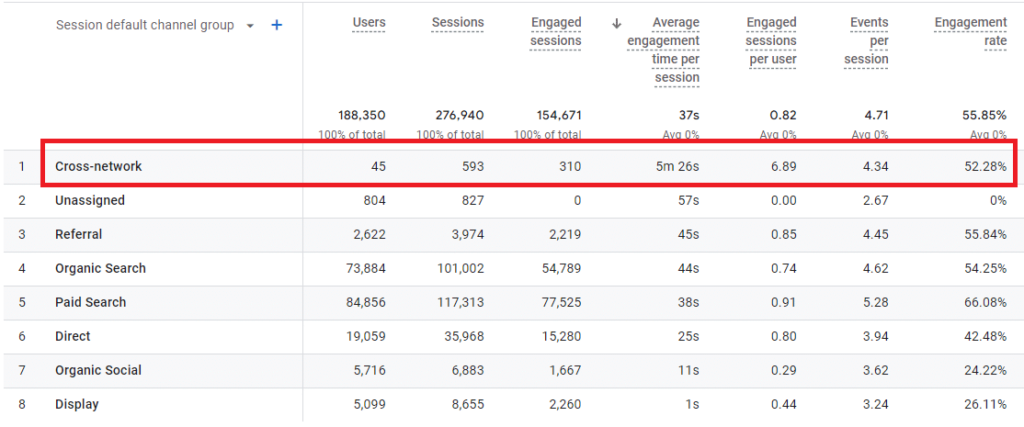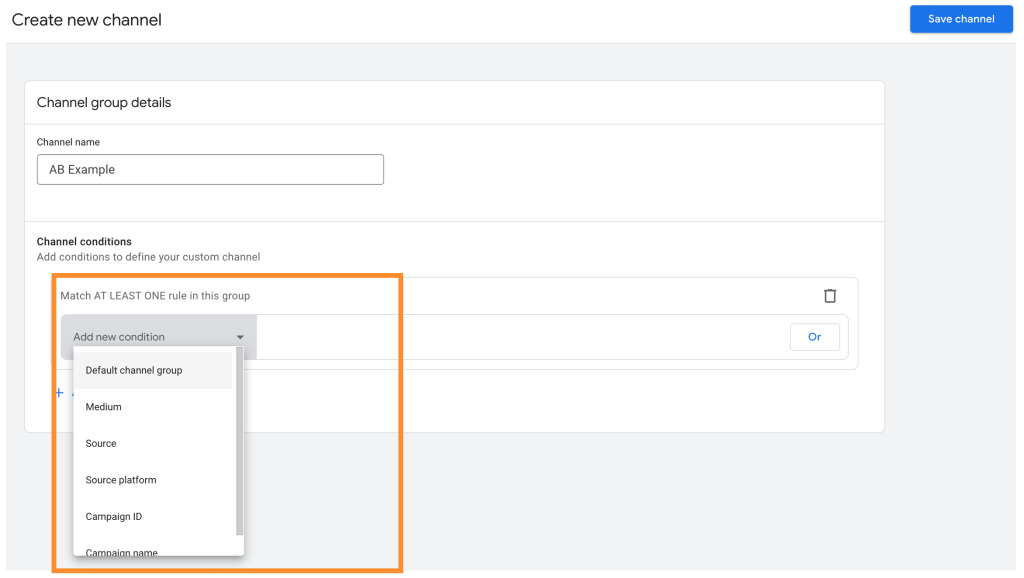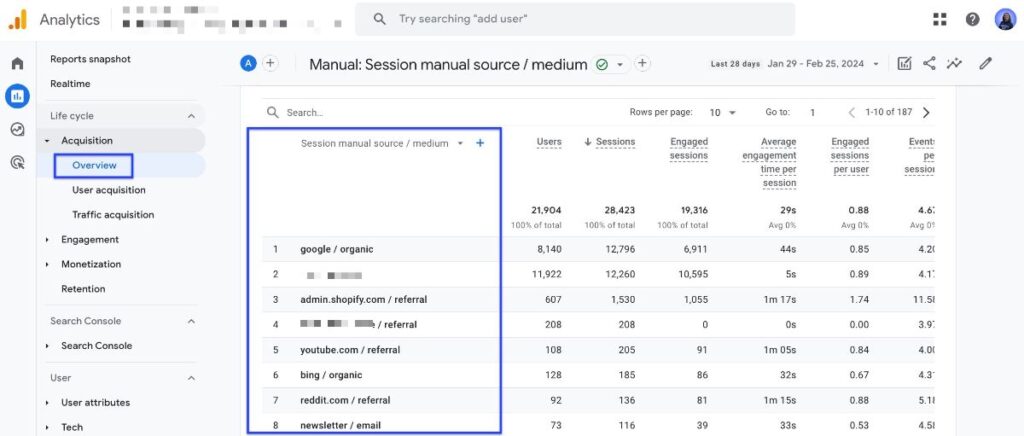The cross-network channel in GA4 shows visits from all your Google ads in one group.
This traffic comes from:
- Google Discover Traffic
- Google Performance Max Campaigns
- Google Shopping Campaigns
Cross-network channel grouping works in a different way to other channels in GA4. It includes campaigns that run across several Google platforms at the same time. These platforms include:
- Google Display Network
- Google Discover
- Gmail
- YouTube

Table of Contents
- How GA4 Groups Traffic Into Default Channels
- Cross-Network Data Attribution Problems
- How to Fix Cross-Network Attribution Issues
- Benefits of Cross-Channel Grouping
- Cross-Network vs Other GA4 Default Channels
- Best Practices for Cross-Network Analysis
- Frequently Asked Questions
Tl;Dr
GA4 puts all Google Ads traffic into one cross-network channel. This includes Google Discover, Performance Max, and Shopping campaigns. You get a simple view of all platforms together. But you can’t see which platform drives your best results. Fix this by making custom channel groups and using GA4’s source platform feature.
How GA4 Groups Traffic Into Default Channels
GA4 groups traffic into various default channel groupings for attribution analysis.
Paid Shopping Channel
GA4 places any traffic into this channel when it comes from Google Ads tagged with the Shopping tag. Your main example would be products listed in the Google Shopping section of the SERP.
Paid Search Channel
GA4 places traffic into this channel from Google Ads with the following tags:
- Google Search
- Google Partners
This traffic comes from sponsored listings on the SERP. Or even ads on YouTube, a Google-owned website.
Paid Video Channel
Paid video traffic comes from ads with YouTube Search or YouTube Video tags. The primary example here is traffic coming from sponsored YouTube videos.
Display Channel
Display traffic comes from any Google Ads campaign with a Google Display Network tag. Any traffic coming from Google Display Network will show on this channel.
Paid Social Channel
GA4 shows paid social ad traffic in this channel. It comes from advertisements with the Social tag enabled. Common examples are ads from social networks like Facebook, X, and Instagram.
Cross-Network Channel Definition
The cross-network channel shows all traffic from Google Ads with the Cross-Network tag. This could be traffic from:
- Google Discovery
- Performance Max campaigns
- Google Smart Shopping
Side note: If you wish to learn how to find referral traffic in Google Analytics 4 and what it means, check our guide on the blog.
Cross-Network Data Attribution Problems in GA4
Grouping traffic from different networks in one channel creates significant attribution challenges. SEO specialists lose important data about where their traffic originates.
You Can’t Identify Which Network Drives Performance
When networks group together, you can’t tell which one brought you a visitor. You can’t see which network led to a conversion. This makes it hard to see how each ad network is doing in your reports.
When a network stops working, you need to find it fast. Without clear data segmentation, you have to guess what went wrong. Guessing leads to poor optimization decisions.
GA4’s Data-Driven Attribution Model Creates Confusion
GA4 uses a data-driven attribution model that splits credit between touchpoints. The algorithm decides how much credit each step gets. This makes it hard to know how much each network contributed to conversions.
GA4 tries to show the full customer journey picture. But when networks work together in cross-network campaigns, attribution gets messy. You can’t tell how much each network has contributed to your entire performance.
This attribution confusion hurts your ability to analyze campaign effectiveness. You can’t give each channel the right budget.
Limited Network-Level Optimization Data
If you don’t know which network works best, you can’t improve your ad campaigns. You can’t move budgets to better-performing networks. You can’t change strategies based on granular performance data.
Say you want to increase spend on Performance Max campaigns. But you don’t know which landing pages work best for these campaigns. You can’t know where to put the extra budget you have.
Campaign-Level Performance Visibility Issues
Enterprise-level marketers often run lots of different campaigns at the same time. GA4 lumps all cross-network results together in one channel. You can’t see what each individual campaign contributed.
This makes it impossible to know which campaigns help your business most. You can’t calculate accurate campaign-level ROI or determine individual campaign value.
How to Fix Cross-Network Attribution Issues
Now we know what goes wrong with GA4’s cross-network channel. Here are some solutions to these attribution problems.
Create Custom Channel Groupings in GA4
Custom channel groups let you organize your channels based on your business requirements. You can group them based on what matters to your attribution analysis. This helps you identify which channels work best for your specific goals.
When you create these custom groupings, you can spot your best performers. You can then give more budget into the channels that bring you the most value.

Use GA4’s Source Platform Dimension
GA4 has a source platform feature that shows you exactly where your traffic comes from. It breaks down results by each individual platform. This gives you granular visibility into your attribution data.
You can see which platforms work well in your customer journey. You can also spot the ones that need optimization. This helps you create better-targeted campaigns.

Use Other Analytics Tools
GA4 is powerful, but it’s not perfect for all attribution needs. Using other analytics tools helps you see how your marketing is actually doing.
You can use CRM systems to track customers better across touchpoints. Advanced attribution software shows you more detailed touchpoint analysis. Business intelligence platforms help you dig deeper into your performance data.
These supplementary tools fill in the gaps that GA4 leaves behind. They show you more about how customers behave and how campaigns perform on their own.
Test Different Attribution Models
You don’t have to stick with GA4’s default data-driven attribution model. You can try different ways to track results to find what works best for your business.
You can try last-click models that give all credit to the final touchpoint. First-click models give credit to the first touchpoint. Linear models spread credit evenly across all touchpoints. Time decay models give more credit to recent touchpoints.
Testing different models helps you find what matches your customer journey best. This leads to better decisions about where to spend your marketing budget.
Benefits of Cross-Channel Grouping
Cross-network grouping in GA4 does have significant benefits for SEO specialists. It can help your marketing analysis in several important ways.
Consolidated Multi-Platform Campaign Overview
Cross-network grouping shows you all your Google advertising traffic in one consolidated view. You can see the total impact of your ads across different platforms. This includes Google Discover, Performance Max campaigns, and Google Shopping campaigns.
This consolidated view makes campaign tracking easier. You don’t have to jump between different reports. You save time and make fewer mistakes when analyzing your performance data.
Simplified Campaign Management Workflows
Running campaigns on different Google platforms at the same time can be complex work. Cross-network grouping makes it simpler to manage. You can see all your campaigns in one unified view.
You can track ads on Google Display, Discover, Gmail, and YouTube all at the same time. This makes it easier to spot performance issues and make strategic changes.
When you see it all together you can make sure every campaign supports the same goal. This helps your marketing strategy work more effectively.
Cross-Platform Synergy Analysis
Cross-network grouping shows you how different Google platforms help each other. You can see how they work together in your customer journey and attribution path.
Some platforms might work better when combined with others. You might miss how platforms work together if you only look at them one by one.
This consolidated view helps you make smarter choices about your budget allocation. You can find the best combinations of platforms. You can put your money where it will generate the most impact.
Cross-Network vs Other GA4 Default Channels
It’s important to know how cross-network is different from other GA4 channels.
Cross-network groups traffic from many Google ad platforms. Other channels usually show one traffic source or campaign type.
This difference affects how accurate your tracking is. It also changes how you improve your campaigns.
Channels like Paid Search or Display show clearer paths. But cross-network needs more digging to see what each platform really adds.
Best Practices for Cross-Network Analysis
Use these tips to get more value from cross-network data in GA4:
Segment Your Analysis
Use GA4 exploration reports to split cross-network traffic by source. This helps you see what each platform is doing.
Create Custom Dimensions
Put in place custom dimensions for enhanced cross-network tracking and attribution analysis.
Test Attribution Models
Check how cross-network traffic performs with different models. This helps you find what fits your business best.
Check Landing Pages
Look at how landing pages work for cross-network visits. Improve the ones that don’t lead to action.
Budget Allocation Testing
Test different budget allocations across cross-network campaigns to optimize performance.
Frequently Asked Questions
What Does Cross-Network Include in GA4?
Cross-network groups traffic from these Google platforms:
- Google Discover ads
- Performance Max campaigns
- Google Shopping campaigns
- Google Display Network ads
- Gmail ads
- YouTube ads
Any Google Ads campaign that runs on multiple platforms gets put in this channel.
Why Does GA4 Group These Networks Together?
GA4 groups these networks because they work as one big campaign. Performance Max campaigns run on Google Search, Display, YouTube, Gmail, and Discover all at once. GA4 treats them as one effort, not separate campaigns.
How Do I See Individual Platform Performance?
You can break down cross-network traffic in three ways:
Use Source Platform Dimension
Go to GA4’s source platform feature. This shows you exactly which platform brought each visitor.
Make Custom Channel Groups
Create your own channel groups based on what matters to your business. Group platforms by performance or campaign type.
Use Exploration Reports
Run exploration reports in GA4. Segment cross-network traffic by source to see detailed breakdowns.
How Is Cross-Network Different From Other GA4 Channels?
Cross-network splits credit between multiple platforms using GA4’s data-driven model. Other channels like Paid Search show clear, direct paths. Cross-network shows a more complex journey across platforms.
Regular channels track one traffic source. Cross-network tracks many sources working together.
Should I Stop Using Cross-Network Campaigns?
No. Cross-network campaigns work well for reach and sales. Don’t avoid them. Instead:
- Make custom channel groups
- Use source platform analysis
- Test different tracking models
- Add other tracking tools to GA4
These steps give you clear performance data without losing campaign effectiveness.
Can I Use Cross-Network Data for SEO?
Cross-network focuses on paid ads, not organic search. But you can still get SEO insights:
Landing Page Performance
See which pages work well with cross-network traffic. Use this data to improve your SEO pages.
User Behavior Patterns
Understand how users interact with content across Google platforms. Apply these insights to organic content.
Content Ideas
Find content that works across multiple Google platforms. Create similar content for SEO.
For direct SEO tracking, use GA4’s organic search channel instead.
Wrapping Up: Optimizing Cross-Network Performance in GA4
Cross-network grouping in GA4 is important for today’s SEO specialists and digital marketers. It shows you all your Google advertising traffic in one consolidated place. It makes tracking your ads easier across different platforms.
This approach helps you manage multi-platform campaigns better. This matters even more when you run ads on Display, Gmail, and YouTube at the same time.
Cross-network grouping shows you how your campaigns work together. This helps you make better decisions about where to spend your marketing budget.
Yes, it has attribution challenges. Data attribution can get confusing when platforms are consolidated. But the solutions we discussed can help you fix these issues.
Custom channel groups give you more granular control. The source platform feature shows you more detailed attribution data. These tools help you work around the consolidation problems.
In the end, cross-network grouping makes your marketing analysis better when implemented correctly. It helps you make smarter attribution decisions. It helps you get more value from your marketing budget allocation.
If you manage Google ads on many platforms you need to understand what cross-network can and can’t show. Use smart workarounds to track results better and spend your budget more wisely.
Do you want to unlock the full potential of your SEO efforts? Then try SEOTesting.
Sign up for a free 14-day trial and experience our seamless integration with GA4. Track your changes’ impact on default and custom events within GA4, ensuring you make data-driven decisions for your website. Don’t miss out on the opportunity to optimize your SEO strategy based on data, not assumptions.
Start your free trial today at SEOTesting!

